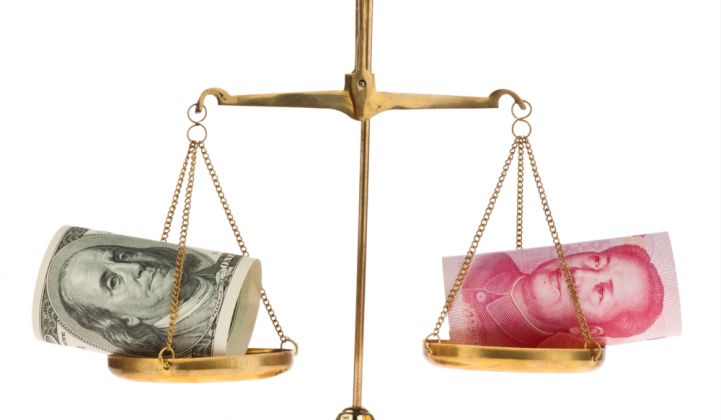SolarWorld just announced an expansion of its solar module factory capacity during a bit of celebration in Oregon this morning.
In June, German-owned, Oregon-based SolarWorld Americas won its trade case when the Department of Commerce found in favor of the company's claim against Chinese solar module makers. The preliminary decision imposed significant tariffs on Chinese solar modules in the anti-dumping portion of this case. The decision also closed what SolarWorld called a "loophole" that allowed Chinese module manufacturers to use Taiwanese cells in their modules, thereby circumventing U.S. trade duties. SolarWorld has prevailed at pretty much every step of this case, despite ineffective opposition from the Coalition for Affordable Solar Energy featuring Jigar Shah, and other trade organizations like SEIA.
Most of the Chinese firms are now paying combined duties of about 47 percent.
On a related and arguably causal note, the addition of a new production line in Hillsboro, Ore. boosts the SolarWorld panel-assembly factory’s capacity from 380 megawatts up to 530 megawatts, with 630 megawatts envisioned for the near future. The expansion also adds 100 megawatts of passive emitter rear contact (PERC) cell production capacity for a total of 435 megawatts. The company expects to build 60-cell mono-crystalline solar modules with power densities greater than 280 watts-peak.
The expansion will add a potential 200 jobs in the first half of 2015 and bring the total number of full-time employees to 900. SolarWorld employs 3,400 people worldwide. SolarWorld called its Oregon factory the "largest of its kind in the Western Hemisphere."
SolarWorld's growth news comes amidst a period of worldwide solar expansion, with capacity announcements trending across a healthy solar market.
Attending this morning's news conference, Oregon's Sen. Wyden (D-Ore.), chairman of the U.S. Senate Committee on Finance, said, “These are jobs worth fighting for, which is why I have worked side by side with SolarWorld to ensure our trade agreements with China are actually enforced."
The senator asserted that China had been taking American manufacturing and jobs. But, he said, "The country is back to enforcing its trade laws. If you don't have manufacturing, you can be held hostage," adding, "The corner is being turned, because those laws are being enforced."
SolarWorld U.S. President Mukesh Dulani said, "We were able to prove again and again that China was cheating." He continued, “We have always said that SolarWorld could compete with any company, foreign or domestic. We pursued our trade cases against the Chinese government and Chinese manufacturers to counter practices we thought were illegal. So far, I am pleased to say we have won every decision."
He added, "Today we stand to say to our workers and our children...that solar manufacturing is here to stay."
With key trade process milestones coming up in next few weeks, Dulani, Wyden and SEIA have all sent strained signals of a willingness to negotiate. Dulani spoke of hammering out "a global settlement so we can resolve this and put this behind us once and for all." Wyden also spoke of a "global settlement." (GTM Senior Editor Stephen Lacey looked at the settlement issue here.)
Any type of settlement or suspension agreement would have to occur before mid-December. Dulani said that he is willing to discuss a settlement, but it "must be enforceable."
Dulani added that this "had been a very long battle to save the U.S. solar industry. This day marks a great turnaround for this company. SolarWorld is growing again, and growing in many ways."
Last week, SolarWorld won a $4 million U.S. DOE SunShot award to "develop a silicon ingot growth technology to enable cost-competitive domestic manufactured silicon wafers for PV modules."
In 2013, imports of crystalline silicon photovoltaic products from China and Taiwan were valued at an estimated $1.5 billion and $656.8 million, respectively. Chinese companies supplied 31 percent of the modules installed in the U.S. in 2013, and more than 50 percent in the distributed solar market, according to GTM Research. Non-Chinese suppliers are likely to gain share as a result of the erosion of Chinese price advantage in the U.S. market. Likely beneficiaries include REC, SolarWorld, Suniva and LG Solar in the distributed solar market, and First Solar in the utility market.
The Commerce Department still has some SolarWorld business on its plate: Commerce might rule as soon as Nov. 13 to reexamine the trade case in light of the alleged cyberhack of SolarWorld’s systems "by a unit of the People’s Liberation Army in 2012." On Dec. 17, Commerce will announce its final rulings on SolarWorld’s anti-dumping and countervailing duty petitions against manufacturers from China and Taiwan.



